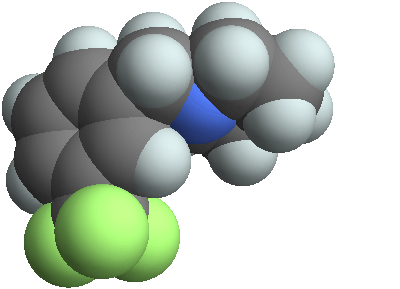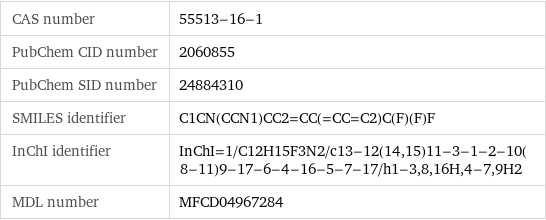Input interpretation
![1-[3-(trifluoromethyl)benzyl]piperazine](../image_source/fd9efba7c4d8eb0ee6c61c081ed07722.png)
1-[3-(trifluoromethyl)benzyl]piperazine
Chemical names and formulas
![formula | C_12H_15F_3N_2 name | 1-[3-(trifluoromethyl)benzyl]piperazine IUPAC name | 1-[[3-(trifluoromethyl)phenyl]methyl]piperazine alternate names | 1-[[3-(trifluoromethyl)phenyl]methyl]piperazine mass fractions | C (carbon) 59% | F (fluorine) 23.3% | H (hydrogen) 6.19% | N (nitrogen) 11.5%](../image_source/b78e84251c3213fa0acce958d825da9a.png)
formula | C_12H_15F_3N_2 name | 1-[3-(trifluoromethyl)benzyl]piperazine IUPAC name | 1-[[3-(trifluoromethyl)phenyl]methyl]piperazine alternate names | 1-[[3-(trifluoromethyl)phenyl]methyl]piperazine mass fractions | C (carbon) 59% | F (fluorine) 23.3% | H (hydrogen) 6.19% | N (nitrogen) 11.5%
Lewis structure
![Draw the Lewis structure of 1-[3-(trifluoromethyl)benzyl]piperazine. Start by drawing the overall structure of the molecule, ignoring potential double and triple bonds: Count the total valence electrons of the carbon (n_C, val = 4), fluorine (n_F, val = 7), hydrogen (n_H, val = 1), and nitrogen (n_N, val = 5) atoms: 12 n_C, val + 3 n_F, val + 15 n_H, val + 2 n_N, val = 94 Calculate the number of electrons needed to completely fill the valence shells for carbon (n_C, full = 8), fluorine (n_F, full = 8), hydrogen (n_H, full = 2), and nitrogen (n_N, full = 8): 12 n_C, full + 3 n_F, full + 15 n_H, full + 2 n_N, full = 166 Subtracting these two numbers shows that 166 - 94 = 72 bonding electrons are needed. Each bond has two electrons, so in addition to the 33 bonds already present in the diagram add 3 bonds. To minimize formal charge carbon wants 4 bonds. Identify the atoms that want additional bonds and the number of electrons remaining on each atom: Fill in the 3 bonds by pairing electrons between adjacent highlighted atoms. Note that the six atom ring is aromatic, so that the single and double bonds may be rearranged: Answer: | |](../image_source/e434bb168c7e498a4fe06666672b3e33.png)
Draw the Lewis structure of 1-[3-(trifluoromethyl)benzyl]piperazine. Start by drawing the overall structure of the molecule, ignoring potential double and triple bonds: Count the total valence electrons of the carbon (n_C, val = 4), fluorine (n_F, val = 7), hydrogen (n_H, val = 1), and nitrogen (n_N, val = 5) atoms: 12 n_C, val + 3 n_F, val + 15 n_H, val + 2 n_N, val = 94 Calculate the number of electrons needed to completely fill the valence shells for carbon (n_C, full = 8), fluorine (n_F, full = 8), hydrogen (n_H, full = 2), and nitrogen (n_N, full = 8): 12 n_C, full + 3 n_F, full + 15 n_H, full + 2 n_N, full = 166 Subtracting these two numbers shows that 166 - 94 = 72 bonding electrons are needed. Each bond has two electrons, so in addition to the 33 bonds already present in the diagram add 3 bonds. To minimize formal charge carbon wants 4 bonds. Identify the atoms that want additional bonds and the number of electrons remaining on each atom: Fill in the 3 bonds by pairing electrons between adjacent highlighted atoms. Note that the six atom ring is aromatic, so that the single and double bonds may be rearranged: Answer: | |
3D structure

3D structure
Basic properties

molar mass | 244.26 g/mol phase | liquid (at STP) boiling point | 90 °C (measured at 6.665 Pa) density | 1.179 g/cm^3
Units

Liquid properties (at STP)

density | 1.179 g/cm^3 refractive index | 1.49
Units

Chemical identifiers

CAS number | 55513-16-1 PubChem CID number | 2060855 PubChem SID number | 24884310 SMILES identifier | C1CN(CCN1)CC2=CC(=CC=C2)C(F)(F)F InChI identifier | InChI=1/C12H15F3N2/c13-12(14, 15)11-3-1-2-10(8-11)9-17-6-4-16-5-7-17/h1-3, 8, 16H, 4-7, 9H2 MDL number | MFCD04967284
Safety properties

flash point | 110 °C